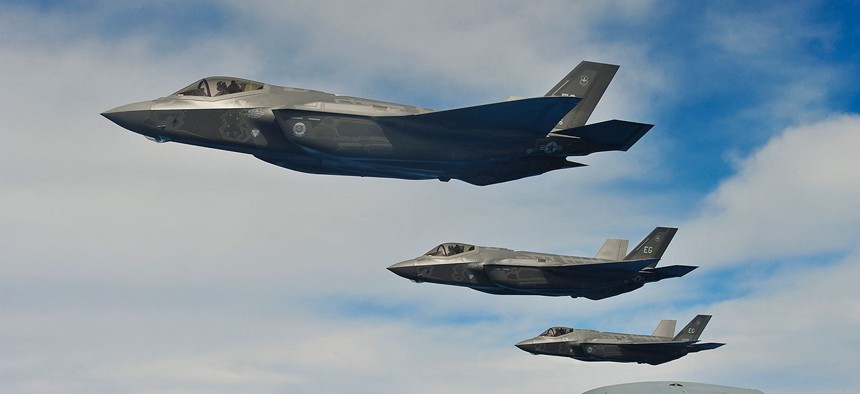F-35 is ‘Ready For War;’ Now the Air Force Wants More, and Faster
Buying more JSFs would lower the per-plane price tag and allow the service to retire older jets sooner.
The U.S. Air Force has declared its F-35A Joint Strike Fighter ready for war, the latest positive step for the expensive project in recent months. Now the Air Force wants more of them.
“The discussion often goes to how many we’re going to buy,” Gen. Herbert “Hawk” Carlisle, the head of Air Combat Command, told reporters. “My problem is buy rate. I need more, faster to replace aging aircraft.”
In June, Pentagon officials reaffirmed the need to buy a total of 2,443 of the warplanes for the Air Force, Marine Corps, and Navy. Now Carlisle, along with other Pentagon officials and plane-maker Lockheed Martin, say buying more jets will lower their expensive per-plane price tag. The Air Force currently spends about $100 million (in 2012 dollars) to buy each F-35A; its goal is push that down to $85 million by the end of the decade.
“If you buy more, it drives the cost down,” Carlisle said.
Obtaining F-35s faster would also allow the service to more quickly retire old and maintenance-hungry F-16s. Delays in the F-35 program have kept many F-16s flying longer than expected, and some will need expensive overhauls if they are not retired soon.
“I would like to see the number go up to at least 60 [F-35 per year] if I can,” Carlisle said. “Eighty would be optimum, but given the fiscal constraints that we’re in today, 80 would be very, very hard to get to.”
It would be hard enough to achieve 60 in the next few years. In the Pentagon’s 2017 budget proposal, which Congress has not yet approved, the Air Force asked for 43 F-35s. Current plans would reach reach 60 planes per year in 2021.
Ready for War
Right now, the Air Force’s battle-ready fleet of F-35s consists of 15 planes at Hill Air Force Base in Utah. Carlisle took pains to underscore that jet could fight if needed.
“If a combatant commander comes to the U.S. Air Force … and asks for a capability that the F-35 has, I would deploy it in support of operations,” he said.
Currently, it could take on a limited set of missions: it can fly “basic” close air support, interdict enemy aircraft, and carry out “limited” suppression of enemy air defenses. It will be several years before F-35s can carry a full arsenal of weapons, and before all of its high-tech sensors, software, and displays are operational.
“You have to get the airplane out there and fly it to be able to determine those things,” Carlisle said.
In the meantime, the aircraft will participate in training exercises. Carlisle said he would like to send the F-35 to Europe and the Pacific within the next 18 months. Allies are interested in seeing the jet fly alongside their planes in drills. Deploying for these wargames reassures allies and serves as a deterrent.
“When the F-35 deploys to places … it will give our allies and partners confidence in the airframe,” Carlisle said.
The Marine Corps said its version of the F-35 was ready for war last summer, but it still hasn’t deployed them.
NEXT STORY: Obama's Historic Day of Clemency




